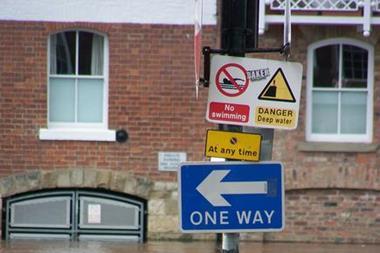Ellen Bennett reports on the issue of flood mapping and how, and where, government funding is being spent
James Brayshaw, the Ordnance Survey’s (OS) director of sales and market development, says that while flood mapping data has improved in recent years, it still has a long way to go.
He said: “The data available today both in terms of the geography that is needed to work out where the weak points and issues will occur has improved significantly over the last few years.
“The models that are built traditionally are principally around river flooding and they rely on a certain level of accurate information.
“That information is historically based in the 1970s, which is when it was put together, so the flood models use data that is not that accurate.
“The OS, together with the Environment Agency, the Metrological Office and a few other organisations who are at the sharp end in terms of information collection, have recognised the need to improve that.
“We have a project with the unfortunate name of Project Atlantis, which is looking at better information for flood and water management. We have deliberately looked at the issue of water management and what that means for things like drains and flows across the ground just in terms of the rivers,” he said.
“We have been working for two and a half years to create better data that will support much more accurate information around localised flooding, because local flooding accounts for a lot of the issues. That comes down to the capacities of the drains and from an engineering point of view you can have much greater levels of prediction around that.”
He added that the responsibility is spread around a wide range of organisations, such as the Environment Agency (EA) and local authorities. “You do not have one body that can look at a geography, a county or an area – take responsibility for all of that analysis and come up with the prediction that flooding is going to occur. While the information can be improved, and we are doing a lot to enhance that now, a lot of insurers and modelling companies are starting to build the next generation of models from that.
“There is also a need to join up across a number of areas of both central and local government to get a better co-ordinated approach to this. We then need to look at things like the nature of flood defences and how that money can be applied.”
Following this statement, Andrew Thompson, international development and data director, Royal Institution of Chartered Surveyors, asked: “What are the current expenditure estimates for flood defences; who prepares them; how is the expenditure segmented and how is it validated to see if it is enough?”
In response, Swenja Surminski, the ABI’s policy advisor on climate change, emphasised that this was a complex procedure.
She said: “Who decides the level of funding? That is quite obvious; it is government and the Treasury. There are bits of money that come through the Environment Agency and the Department for the Environment, Farming and Rural Affairs (DEFRA). DEFRA has the overall responsibility for flood risk management. The EA looks into flood defences and river and coastal flooding.
“There was an announcement this summer that the spend on flood defences would be increased, reaching £800m per year by 2010/11. You have to bear in mind that there is a Comprehensive Spending Review at the moment and the government is just about to announce the next round of spending. That is why there is this three to four year plan.
“I think there are a couple of caveats involved and we have been asking to see details of what that announcement actually means in terms of what happens next year and the year after; where does the money go.
“Unfortunately we have not seen any confirmation and we understand we are probably unlikely to see any before the official announcements late in October.”
James Brayshaw then explained how the EA is attempting to bring information together to inform where priority expenditure should be. He said: “Again it keeps coming back to having to improve the level of information that OS and the EA have. There is still a lot of work to do to find out where the best places are to spend that money.
“Inevitably, I suspect, from a personal point of view the expenditure will not match the need.
R&SA’s Alan Gairns emphasised the need for extra funding to be provided quickly. He said: “If you take the statement of principle, the key thing in there was that the government was going to protect 150,000 homes by 2008.
“Now, current expenditure is £564m. In terms of the lobbying issues we are looking for something in the region of £770/775m, allowing for inflation and also some of the issues that came out of the Foresight Report in terms of climate change. The government said £800m and that in itself looks good, but then we have all the other issues, such as the maintenance of defences and now drainage issues.
“I think what is key for me is that [environment secretary] Hilary Benn said £800m by 2010; we are at £564m and I think we would prefer to see £800m in 2008, not 2010.
“We were having that discussion with the Treasury today to emphasise that they need to put more money into it. My view is that the statement of principle was good in 2000; it has created a balance of cover continuance; it allows the mortgage industry to continue, while government funds the defences, but we are now seven years down the line and by the end of the next Comprehensive Spending Review we will be at 2010.
“Ten years later is it still relevant that the statement of principle continues; where is the endpoint in this and how big is this problem that still has to be addressed?
“I think we want to see much more in terms of what value we are getting for this £800m or whatever the figure is going to be in 2008 and exactly where it is going to be spent – is it being spent in the right places?
“Ordnance Survey is doing some work to identify the key areas, where we will get the biggest benefit and that has to be a plus.””





































